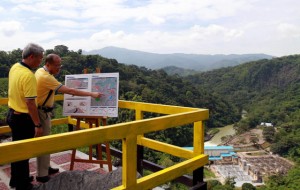NORZAGARAY, Bulacan: President Benigno Aquino 3rd on Wednesday inspected a retrofit project that will make Angat dam resist a possible 7.2-magnitude earthquake.
In his speech, Aquino noted that the P1.08-billion Angat dam and dike rehabilitation project would address the problems on safety and structural integrity of the 47-year old reservoir.
“We are doing everything that we can in rehabilitating the dam. Our objective is to ensure the stability of the dam and dike so that even with a 7.2 magnitude earthquake as strong as the one that struck Bohol in 2013, the structure can still withstand the shaking,” he said in Filipino.
Aquino announced that the government will set up a P261-million flood forecasting and warning system for the water reservoir.
He said flood control protection works, worth P292 million, will also be implemented.
Strengthening the dam has become a foremost concern especially after the Philippine Institute of Volcanology and Seismology (Phivolcs) in 2002 warned against the potentially active West Valley Fault, which runs 200 meters east of the main Angat dike.
Aquino said the West Valley Fault is near Angat dam and dike, labeled “conditionally poor” because of questionable stability and structure and lack of surveillance system.
The President warned that destruction of Angat dam could injure or kill three million Filipinos in Bulacan and Pampanga.
“We don’t want this to happen and the importance of this project is very clear to us,” “ Aquino said.
Angat dam is a concrete water reservoir embankment hydroelectric dam that supplies more than 90 percent of Metro Manila’s water requirements.
The dam system is also responsible for the irrigation of 25,000 hectares of farm lands in Bulacan and Pampanga, power generation of 246 megawatts for the Luzon grid and for flood control.
The Angat dam and dike strengthening project is being funded and spearheaded by the Angat Hydropower Corporation (AHC), which is co-owned by K-water and San Miguel Corporation’s SMC Global Power through its subsidiary Power Ventures Energy Inc.
The AHC’s acquisition of the Angat Hydroelectric Power Plant resulted in the company’s commitment to strengthen and maintain the dam system based on an assessment study conducted by independent engineering firm Poyry Energy Ltd.
The study showed that Angat dam will remain safe in case of extreme flooding as long as its three spillway gates remain functional.
Meanwhile, in case of an earthquake, Poyry Energy recommended increasing the clay portion of the main dam core by 1.3 meters to further strengthen the dam system.
It also suggested widening of the base and downstream slope of the dam and dike using rockfill from a nearby quarry.
AHC estimates that the rehabilitation project will be completed within the next two years.
Be prepared
The Phivolcs has been calling on Metro Manila residents to prepare for a possible earthquake that could hit the area in the next several years and cause more than 30,000 casualties.
Phivolcs Director Renato Solidum said the West Valley Fault, a major fault line that runs through the Metro Manila cities of Marikina, Pasig and Muntinlupa, was known to move every 400 years and the last one was in 1658, or 357 years ago.
“We all need to be proactive,” Solidum told a recent roundtable forum at The Manila Times. “People die because they are not prepared. “
A fault line is a break on the ground that triggers an earthquake as a result of a shift of the earth’s tectonic plates.
The West Valley Fault has moved four times in the past 1,400 years.
There are 10 other faults outside Manila, including the Manila Trench, which is located in the Pacific Ocean, west of Mindoro.
A movement in the Manila Trench can swamp Metro Manila with tsunamis.
Solidum said the key to effective disaster prevention is planning for safety, knowing hazards in an area and evaluating structural soundness of buildings and houses.
WITH JACQUELINE BOUVIER ARIAS AND IZA IGLESIAS


